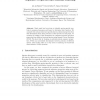62 search results - page 3 / 13 » CONTRAlign: Discriminative Training for Protein Sequence Ali... |
IDEAL
2007
Springer
15 years 6 months ago
2007
Springer
Abstract. Much work has been done to identify species-specific proteins in sequenced genomes and hence to determine their function. We assumed that such proteins have specific ph...
110
click to vote
BMCBI
2008
14 years 12 months ago
2008
Background: Recent approaches for predicting the three-dimensional (3D) structure of proteins such as de novo or fold recognition methods mostly rely on simplified energy potentia...
HPDC
2010
IEEE
15 years 28 days ago
2010
IEEE
A common task in biological research is to predict function for proteins by comparing sequences between proteins of known and unknown function. This is often done using pair-wise ...
BMCBI
2007
14 years 12 months ago
2007
Background: Vaccine development in the post-genomic era often begins with the in silico screening of genome information, with the most probable protective antigens being predicted...
RECOMB
2009
Springer
16 years 13 days ago
2009
Springer
Abstract. Accurate comparative analysis tools for low-homology proteins remains a difficult challenge in computational biology, especially sequence alignment and consensus folding ...

